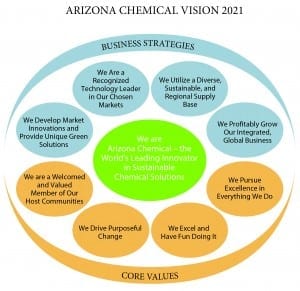
Arizona Chemical (AZC) provides pine chemical products that are used by manufacturers to create hundreds of everyday products, ranging from roads to tires to adhesives. As a privately held company, no public reporting is required by AZC with regard to its sustainability practices. Still, the company wanted to better distinguish itself from competitors and reinforce its market position as a top bio-based company. So, in 2009, AZC released its first sustainability report, which centered on the Global Reporting Initiative (GRI) guidelines—the de facto standard for sustainability disclosures.
But the report didn’t necessarily provide AZC the competitive edge it was hoping for.
At the same time, customers were starting to clamor for more transparency in sustainability supply chain reporting.
Against that backdrop, AZC decided it needed to take the sustainability report to a new level. “It was an opportunity for us to expand, get our message to suppliers and customers, and build our business,” said Alan Phillips, director of sustainability at AZC.
Working with PR agency Strategy XXI Partners, AZC spent the next two years developing content in order to make the sustainability report more accessible, shaping the reporting process into editorial nuggets that could be easily conveyed.
THE GOALS
The chemical company wanted the 2013 report to be much more comprehensive in addressing the concerns among customers and other stakeholders.
More specifically, the goals for the new sustainability report included:
• Deliver key messages that generate awareness and interest among AZC’s stakeholders.
• Define “sustainability” beyond GRI. By making the narrative the first priority of the report (and GRI reporting a second feature), AZC’s audiences would be able to find and understand the information they wanted regarding the company’s perspectives, goals and progress.
• Establish a platform that could be re-used for annual sustainability reporting.
Job One was to create a highlights report in print and a more comprehensive digital edition, so each medium could feed off the other.
A QR code, for example, was placed on each page of the print product in order to encourage readers to get a closer look of specific topics online.
Both the Web and print reports featured photos, descriptive headlines, bullet-pointed highlights, graphs and charts—all designed to enhance the readability of every page.
MORE LIKE A MAGAZINE
The print issue, which ran about 16 pages, delivered the company’s key messages while the digital edition featured a running text that drilled down into the AZC story (with GRI content seamlessly integrated into the running text).
A total of 2,500 print copies were produced and distributed to AZC facilities throughout the world, with the report printed on recycled paper.
Unlike previous sustainability reports, the 2013 print edition was designed to engage readers with more visuals, group shots of employees, coverage of various safety summits and content focusing on business priorities, such as how AZC is constantly enhancing its safety performance.
In contrast, the Web report—crafted as a microsite that was integrated with the corporate website—divided content into more digestible pieces of information on the report’s homepage and in multiple sub-sections. It also featured simple and clear titles for better navigation.
The thinking behind creating two separate reports was to offer a comprehensive deep dive into AZC’s sustainability efforts via the Web while the print report would highlight main messages and be distributed to stakeholders.
The core editorial elements of both the print and online editions homed in on the company’s key talking points, including bio-based raw materials and measurement tools.
“We began by looking to answer [GRI-related] questions, and analyzed ourselves in relation to sustainability objectives,” Phillips said, referring to how the company overhauled the report to make it more robust. “We wanted marketing, sales and procurement and other employees to have a more comprehensive understanding of our capabilities,” he added.
Sales reps were also armed with copies of the print product to distribute to key customers. What is more, AZC established a separate intranet to push out the report internally and encourage employees to comment.
NEW SPRINGBOARD

The new sustainability report has also been used as a PR and marketing vehicle.
According to AZC, virtually 100% of job candidates review the sustainability website and the report before being interviewed. That’s important for recruitment because millennials look for sustainability efforts when they consider a job.
The report gets promoted to stakeholders via the company’s various town hall meetings. It has also sparked the interest of the media. For example, World Highways and other media outlets plan to cover AZC’s new recycled asphalt binder product because editors saw the sustainability report and realized AZC made innovative bio-based products for road construction, Phillips said.
The new report has improved consistency in reporting metrics across facilities, integrated additional measurement into existing business systems, and leveraged customer “scorecards” as a way to determine customers’ biggest concerns.
“It’s been a great way to raise the bar and make improvements in the company,” Phillips said, referring to the sustainability report. “It’s core to the company, our mission and our strategy.”
Sidebar: PR Tips for Telling Your Sustainability Story

Whether called corporate citizenship, corporate social responsibility or sustainability, being responsible to the environment and the community is here to stay. While brands like Apple, Nestlé and Walt Disney Co. have impressed consumers with their CSR/sustainability strategies, B2B companies should try and leverage their programs to increase brand reputation, improve relationships and better manage risk. As more B2B companies use sustainability reporting to measure and communicate progress on material issues, they are expecting similar transparency from their suppliers and business partners. Sustainability reporting encompassing environmental, social, governance and economic impacts should be used to:
• Establish credibility with stakeholders. Companies can build respect, loyalty and mutual understanding by engaging in dialogue with key constituents such as customers, employees, suppliers, investors, communities, governments and non-governmental organizations. It’s not just about proclaiming sustainability victories. It’s a chance to understand your stakeholders’ greatest concerns and share ideas.
• Improve employee retention and new employee recruiting. Sustainability reporting has become the de facto standard for demonstrating corporate commitment to responsible behavior. By providing a consolidated source for this type of information, companies enhance workforce engagement, which in turn results in increased satisfaction and productivity.
• Mitigate risk by identifying gaps in internal operations. A diligent reporting process requires digging deep into the organization for weak links. You may find that consistent metrics are not used throughout the company, for example. Or the organization is not measuring something that is material to the business at all. This awareness leads to action to better manage and control for operational excellence.
• Manage risk from external supply chain sources. While your company does not have direct control over every vendor and its suppliers, what happens to them can potentially harm your organization’s reputation by association with them.
• Drive innovation. The sustainability reporting journey can be an eye-opener to fresh ideas for process improvements and new product development. Recognizing emerging market challenges through a sustainability lens facilitates identification of new areas in which your company can add value.
This sidebar was written by Barbara Shrager, director of Strategy XXI Partners. She can be reached at [email protected].
CONTACT:
Alan Phillips, [email protected].
This article originally appeared in the July 14, 2014 issue of PR News. Read more subscriber-only content by becoming a PR News subscriber today.
